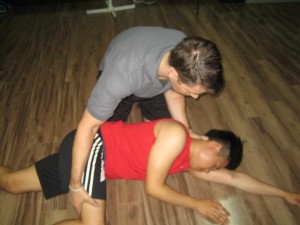Basic Life Support
The American Heart Association created the concept of Basic Life Support to serve as guidelines in addressing healthcare emergencies that compromise respiration and circulation. Cardiac arrest and choking as some of the emergencies that trainees learn to manage in our training programs. The BLS guidelines also teach trainees the Chain of Survival, a series of steps also created by the AHA through research and application that have proven to improve the survival rates of victims of cardiovascular and respiratory emergencies.
The Chain of Survival is made up of five links: (1) recognizing a cardiovascular incident, (2) immediately starting a cycle of 30 chest compressions and 2 rescue breaths and continuing until help has arrived, (3) rapid defibrillation to normalize cardiac rhythm, (4) advanced life support – given in a clinical setting (the ambulance and the ER) by healthcare professionals, and (5) post-cardiac arrest care.
These topics along with basic first aid management are taught in the BLS program for healthcare providers. The two other basic CPR courses also fall under Basic Life Support but only introduce the trainees to the guidelines. These basic CPR programs focus more on skill building.
Becoming certified rescuers

All of the programs offered by our 6 providers in the US are certification courses. Upon completing the lessons and passing the post-tests, rescuers are given credentials – either a card or a certificate – that are valid for two years throughout the US. These credentials certify a person as a trainer CPR rescuer. Rescuers who have near expiry certificates can renew them for another two years through re-certification classes. However, expired certificates are not accepted for re-certification; the rescuer has to retake the training program.
Available training classes in BLS
Basic Life Support for Healthcare Providers (HCPs)
BLS for HCPs teaches students about the American Heart Association’s Basic Life Support guidelines and concepts. The program focuses on addressing cardiac arrest and other similar cardiovascular emergencies. It runs for four and a half hours, and has a four-hour long re-certification program. Students need to pass a skills test and written exam to qualify for this program as well as after to receive certification.
Heartsaver CPR/AED (general public)
This general public course is 4 hours long, without an available re-certification class. The curriculum teaches cardiopulmonary resuscitation skills given to victims before emergency medical help arrives. The program focuses on chest compressions, rescue breaths, and defibrillation. This general public program is an optional certification course wherein students are not required to take the post-test to become certified rescuers.
Heartsaver CPR/AED (healthcare providers)
This program runs for four and half hours and tailors the first Heartsaver CPR/AED for healthcare providers, not necessarily healthcare professionals. The focus of training is also on skill building. A practical and written exam is given to students after the program has been completed to certify them as trained CPR rescuers.
These three classes are available at the following providers over 5 states:
- Los Angeles, California
- San Francisco, California
- Honolulu, Hawaii
- Las Vegas, Nevada
- Portland, Oregon
- Seattle, Washington